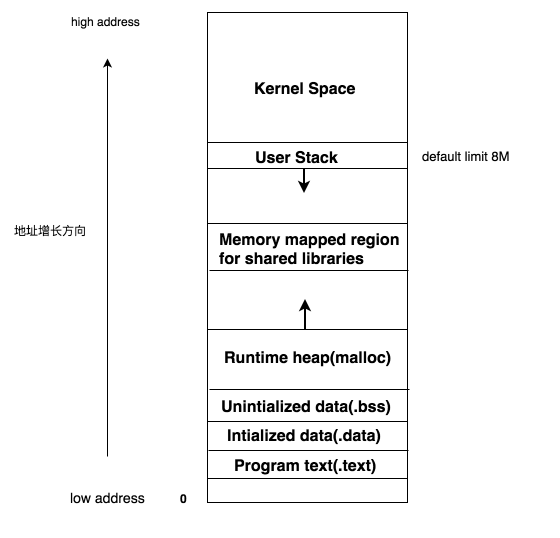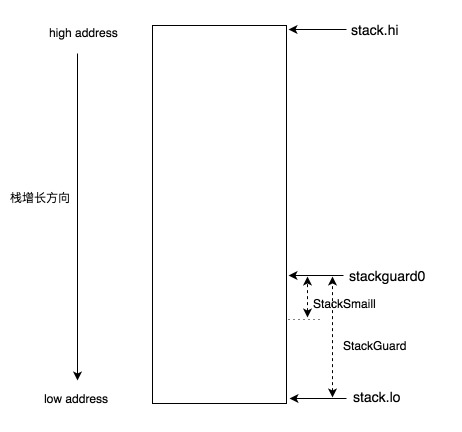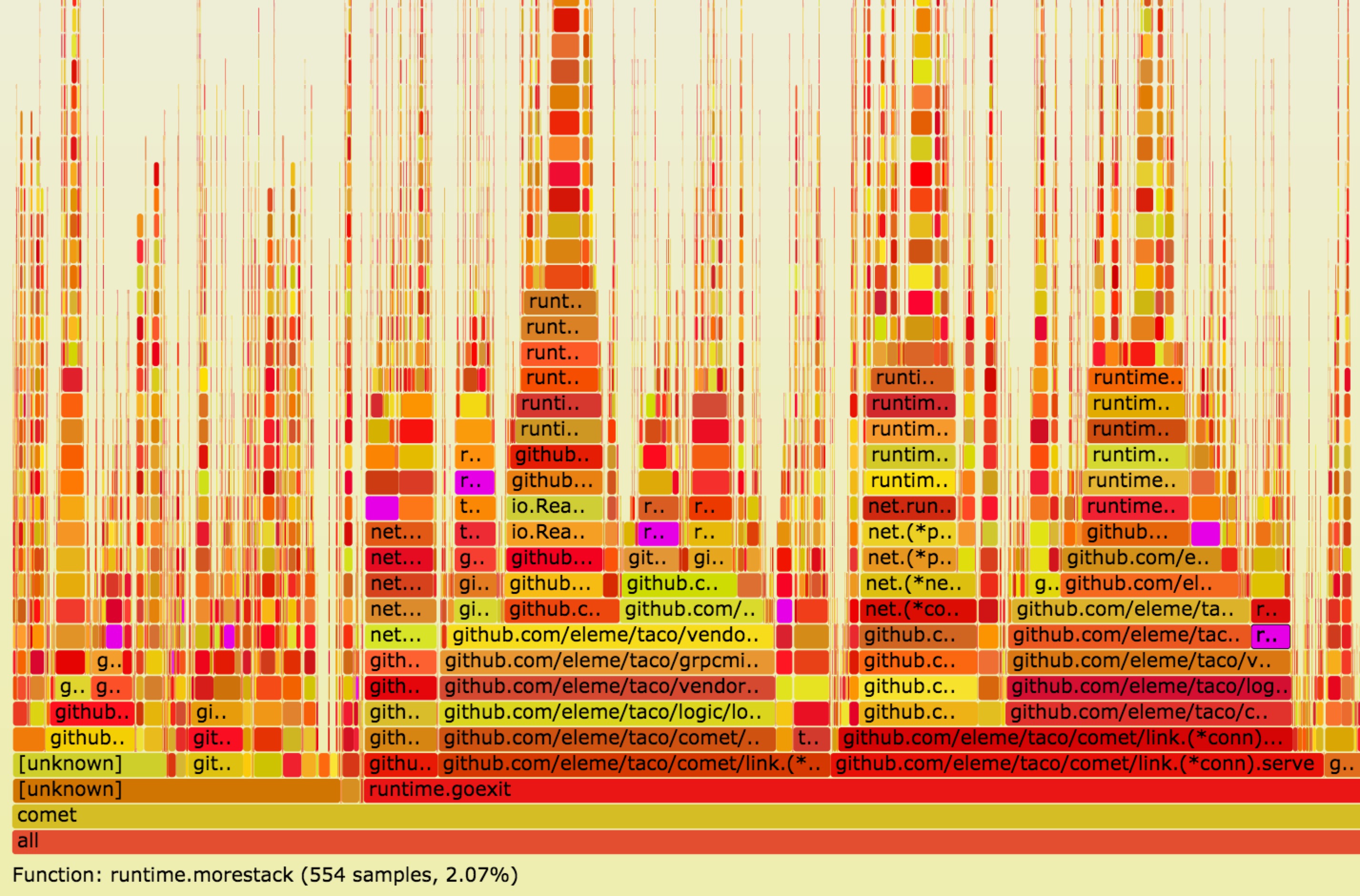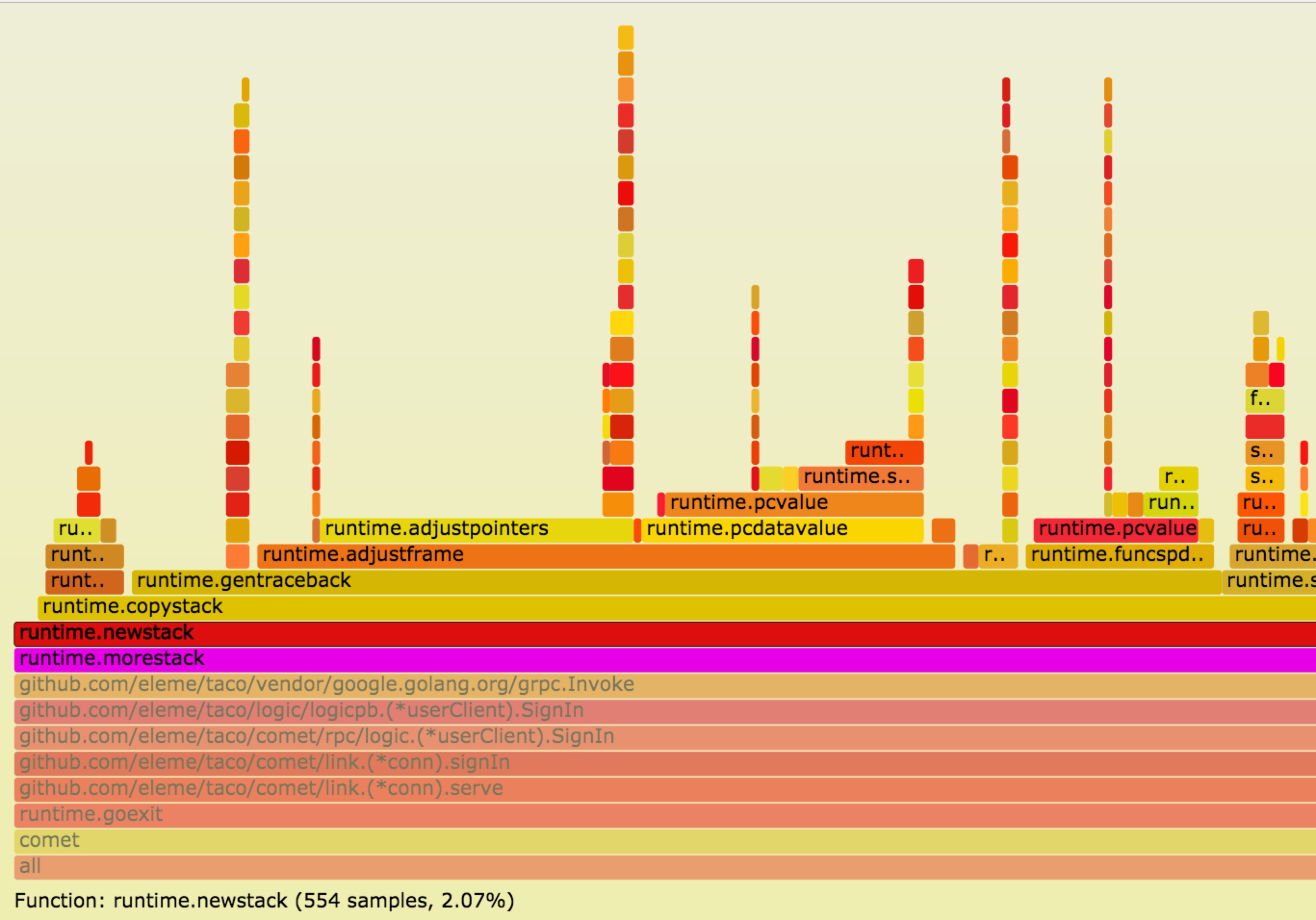聊一聊goroutine stack
2017-07-29
推送在外卖订餐中扮演着重要的角色,为商家实时接单、骑手实时派单提供基础的数据通道。早期推送是由第三方服务商提供的, 随着业务复杂度的提升、订单量和用户数的持续增长,之前的系统已经远远不能满足需求,构建一个高性能、高可用的推送系统势在必行。 今年上半年我们用go开发了一个hybrid push服务,用户在线则借助长连接下发消息,不在线则借助厂商或第三方通道下发消息。 在构建过程中遇到了些与 goroutine stack 相关的问题,这里就和大家扯一扯。
带着问题阅读,才能让阅读更加高效,首先让我们看下问题:
- goroutine stack多大呢?是固定的还是动态变化的呢?
- stack动态变化的话,什么时候扩容和缩容呢?如何实现的呢?
- 对服务有什么影响吗?如何排查栈扩容缩容带来的问题呢?
问题明确了,我们就开始往下扯呗。
栈大小
在了解协程栈之前,我们先看下传统的Linux进程内存布局:

user stack的大小是固定的,Linux中默认为8192KB,运行时内存占用超过上限,程序会崩溃掉并报告segment错误。 为了修复这个问题,我们可以调大内核参数中的stack size, 或者在创建线程时显式地传入所需要大小的内存块。 这两种方案都有自己的优缺点, 前者比较简单但会影响到系统内所有的thread,后者需要开发者精确计算每个thread的大小, 负担比较高。
有没有办法既不影响所有thread又不会给开发者增加太多的负担呢? 答案当然是有的,比如: 我们可以在函数调用处插桩, 每次调用的时候检查当前栈的空间是否能够满足新函数的执行,满足的话直接执行,否则创建新的栈空间并将老的栈拷贝到新的栈然后再执行。 这个想法听起来很fancy & simple, 但当前的Linux thread模型却不能满足,实现的话只能够在用户空间实现,并且有不小的难度。
go作为一门21世纪的现代语言,定位于简单高效,充分利用多核优势,解放工程师,自然不能够少了这个特性。它使用内置的运行时runtime优雅地解决了这个问题, 每个routine(g0除外)在初始化时stack大小都为2KB, 运行过程中会根据不同的场景做动态的调整。
栈扩容和缩容
在介绍具体的栈处理细节之前,我们先了解下协程栈的内存布局和一些重要的术语:

- stack.lo: 栈空间的低地址
- stack.hi: 栈空间的高地址
- stackguard0: stack.lo + StackGuard, 用于stack overlow的检测
- StackGuard: 保护区大小,常量Linux上为880字节
- StackSmall: 常量大小为128字节,用于小函数调用的优化
在判断栈空间是否需要扩容的时候,可以根据被调用函数栈帧的大小, 分为以下两种情况:
小于StackSmall
SP小于stackguard0, 执行栈扩容,否则直接执行。
大于StackSamll
SP - Function’s Stack Frame Size + StackSmall 小于stackguard0, 执行栈扩容,否则直接执行。
runtime中还有个StackBig的常量,默认为4096,被调用函数栈帧大小大于StackBig的时候, 一定会发生栈的扩容,这里就不再展开了。
下面通过一个简单的函数调用,来观察下栈的处理:
package main
func main() {
a, b := 1, 2
_ = add1(a, b)
_ = add2(a, b)
}
func add1(x, y int) int {
return x + y
}
func add2(x, y int) int {
_ = make([]byte, 200)
return x + y
}
禁用优化和内敛进行编译 go tool compile -N -l -S stack.go > stack.s , 部分汇编代码如下:
"".main t=1 size=112 args=0x0 locals=0x30 |
通过上面的汇编码,可以看到当被调用函数栈帧小于StackSmall的时候没有执行栈空间大小判断而是直接执行,在一定程度上优化了小函数的调用。 大于StackSmall的,会执行栈空间大小判断,栈空间不足的时候,通过调用runtime.morestack_noctxt来完成栈的扩容,然后再重新开始执行函数。
go在1.3之前栈扩容采用的是分段栈(Segemented Stack),在栈空间不够的时候新申请一个栈空间用于被调用函数的执行, 执行后销毁新申请的栈空间并回到老的栈空间继续执行,当函数出现频繁调用(递归)时可能会引发hot split。为了避免hot split, 1.3之后采用的是连续栈(Contiguous Stack),栈空间不足的时候申请一个2倍于当前大小的新栈,并把所有数据拷贝到新栈, 接下来的所有调用执行都发生在新栈上。
栈扩容和拷贝不是件容易的事情,涉及到很多内容和细节,这里只介绍下基本过程和算法意图,不会深入到所有细节。
runtime.morestack_noctxt是用汇编实现的,以下是amd64架构的部分代码(runtime/asm_amd64.s):
// Called during function prolog when more stack is needed.
//
// The traceback routines see morestack on a g0 as being
// the top of a stack (for example, morestack calling newstack
// calling the scheduler calling newm calling gc), so we must
// record an argument size. For that purpose, it has no arguments.
TEXT runtime·morestack(SB),NOSPLIT,$0-0
// Cannot grow scheduler stack (m->g0).
get_tls(CX)
MOVQ g(CX), BX
MOVQ g_m(BX), BX
MOVQ m_g0(BX), SI
CMPQ g(CX), SI
JNE 3(PC)
CALL runtime·badmorestackg0(SB)
INT $3
// 省略signal stack、morebuf和sched的处理
...
// Call newstack on m->g0's stack.
MOVQ m_g0(BX), BX
MOVQ BX, g(CX)
MOVQ (g_sched+gobuf_sp)(BX), SP
PUSHQ DX // ctxt argument
// 调用runtime.newstack完成栈扩容
CALL runtime·newstack(SB)
MOVQ $0, 0x1003 // crash if newstack returns
POPQ DX // keep balance check happy
RET
// morestack but not preserving ctxt.
TEXT runtime·morestack_noctxt(SB),NOSPLIT,$0
MOVL $0, DX
// 调用morestack
JMP runtime·morestack(SB)// Called from runtime·morestack when more stack is needed.
// Allocate larger stack and relocate to new stack.
// Stack growth is multiplicative, for constant amortized cost.
//
// g->atomicstatus will be Grunning or Gscanrunning upon entry.
// If the GC is trying to stop this g then it will set preemptscan to true.
//
// ctxt is the value of the context register on morestack. newstack
// will write it to g.sched.ctxt.
func newstack(ctxt unsafe.Pointer) {
thisg := getg()
gp := thisg.m.curg
// 扩容至现在的2倍
oldsize := int(gp.stackAlloc)
newsize := oldsize * 2
// The goroutine must be executing in order to call newstack,
// so it must be Grunning (or Gscanrunning).
casgstatus(gp, _Grunning, _Gcopystack)
// The concurrent GC will not scan the stack while we are doing the copy since
// the gp is in a Gcopystack status.
// 拷贝栈数据后切换到新栈
copystack(gp, uintptr(newsize), true)
if stackDebug >= 1 {
print("stack grow done\n")
}
// 恢复执行
casgstatus(gp, _Gcopystack, _Grunning)
gogo(&gp.sched)
}
// Copies gp's stack to a new stack of a different size.
// Caller must have changed gp status to Gcopystack.
//
// If sync is true, this is a self-triggered stack growth and, in
// particular, no other G may be writing to gp's stack (e.g., via a
// channel operation). If sync is false, copystack protects against
// concurrent channel operations.
func copystack(gp *g, newsize uintptr, sync bool) {
if gp.syscallsp != 0 {
throw("stack growth not allowed in system call")
}
old := gp.stack
if old.lo == 0 {
throw("nil stackbase")
}
used := old.hi - gp.sched.sp
// 从缓存或堆分配新栈
new, newstkbar := stackalloc(uint32(newsize))
if stackPoisonCopy != 0 {
fillstack(new, 0xfd)
}
// Compute adjustment.
var adjinfo adjustinfo
adjinfo.old = old
adjinfo.delta = new.hi - old.hi
// Adjust sudogs, synchronizing with channel ops if necessary.
ncopy := used
if sync {
adjustsudogs(gp, &adjinfo)
} else {
// sudogs can point in to the stack. During concurrent
// shrinking, these areas may be written to. Find the
// highest such pointer so we can handle everything
// there and below carefully. (This shouldn't be far
// from the bottom of the stack, so there's little
// cost in handling everything below it carefully.)
adjinfo.sghi = findsghi(gp, old)
// Synchronize with channel ops and copy the part of
// the stack they may interact with.
ncopy -= syncadjustsudogs(gp, used, &adjinfo)
}
// 拷贝栈到新的位置
memmove(unsafe.Pointer(new.hi-ncopy), unsafe.Pointer(old.hi-ncopy), ncopy)
// 切换到新栈
gp.stack = new
gp.stackguard0 = new.lo + _StackGuard // NOTE: might clobber a preempt request
gp.sched.sp = new.hi - used
oldsize := gp.stackAlloc
gp.stackAlloc = newsize
gp.stkbar = newstkbar
gp.stktopsp += adjinfo.delta
// Adjust pointers in the new stack.
gentraceback(^uintptr(0), ^uintptr(0), 0, gp, 0, nil, 0x7fffffff, adjustframe, noescape(unsafe.Pointer(&adjinfo)), 0)
gcUnlockStackBarriers(gp)
// 释放旧栈
if stackPoisonCopy != 0 {
fillstack(old, 0xfc)
}
stackfree(old, oldsize)
}
栈收缩不是在函数调用时发生的,是由垃圾回收器在垃圾回收时主动触发的。基本过程是计算当前使用的空间,小于栈空间的1/4的话,
执行栈的收缩,将栈收缩为现在的1/2,否则直接返回。下面是栈收缩的部分代码(runtime/stack.go):
func shrinkstack(gp *g) {
gstatus := readgstatus(gp)
if gstatus&^_Gscan == _Gdead {
if gp.stack.lo != 0 {
// Free whole stack - it will get reallocated
// if G is used again.
stackfree(gp.stack, gp.stackAlloc)
gp.stack.lo = 0
gp.stack.hi = 0
gp.stkbar = nil
gp.stkbarPos = 0
}
return
}
// 收缩目标是一半大小
oldsize := gp.stackAlloc
newsize := oldsize / 2
// Don't shrink the allocation below the minimum-sized stack
// allocation.
if newsize < _FixedStack {
return
}
// 如果使用空间超过1/4, 则不收缩
avail := gp.stack.hi - gp.stack.lo
if used := gp.stack.hi - gp.sched.sp + _StackLimit; used >= avail/4 {
return
}
// 用较小的栈替换当前的栈
copystack(gp, newsize, false)
}
扩缩容影响
在正常的http service、rpc service中,栈扩容和收缩的影响几乎可以忽略不计,大家在排查问题的时候可以直接跳过。 在一些对内存占用、延时敏感的服务中,要特别注意,否则将可能面临内存占用高、服务不稳定的状况。
我们用go构建的hybrid push服务,每个连接都是全双工的,使用两个routine来分别处理读写,刚开始上线压测时内存占用非常高,甚至出现OOM的情况。
刚开始怀疑堆占用过高,通过runtime和pprof排查,堆占用和预期设想的一样,
并没有太多的问题 ,一度非常头大。后来通过curl -s http://localhost:port/debug/pprof/heap?debug=1 | grep -A 20 runtime.MemStats
查看MemStats状态,发现Stack占用很高甚至达到了20G,基本上就确定了问题是由栈造成的,接下来就可以通过工具来定位具体的原因了。
我们借助了perf和FlameGraph来trace函数调用,下面是部分截图:


可以看到在rpc调用(grpc invoke)时,栈会发生扩容(runtime.morestack),也就意味着在读写routine内的任何rpc调用都会导致栈扩容, 占用的内存空间会扩大为原来的两倍,4kB的栈会变为8kB,100w的连接的内存占用会从8G扩大为16G(全双工,不考虑其他开销),这简直是噩梦。
解决这个问题的方案有很多,我们选择了channel和worker group,读写routine只负责流量和连接处理,逻辑处理的部分完全交给worker。 优化后,读写routine各占用4KB内存,运行过程中都不会出现栈扩容的问题,单机(24core 32G memory)可以承载100W连接和每秒2~3w消息的发送(512 ~ 1024 byte)。
上面介绍到栈缩容的目标是提高内存利用率,但在缩容过程中会存在栈拷贝和写屏障(write barrier),对于一些准实时应用可能会存在一些影响。 好在go提供了可设置的参数,需要的话大家可以通过设置环境变量 GODEBUG=gcshrinkstackoff=1 来关闭栈缩容。关闭栈缩容后, 需要承担栈持续增长的风险,在关闭前需要慎重考虑。
如果想查看程序运行过程中栈alloc、扩容、拷贝和缩容细节的话,可以通过设置stackDebug变量(runtime/stack.go)为非0,
然后重新编译程序(记得要重新编译runtime, 编译时加入-a参数),就可以看到所有栈操作的细节了。
暂时没有找到更好的设置方式比如GODEBUG之类的,如果大家更好的办法,欢迎告诉我。
备注
上面的所有常量和代码,都是基于Linux x86_64架构,go 1.8.3版本的。
参考文档
- https://blog.cloudflare.com/how-stacks-are-handled-in-go/
- http://www.brendangregg.com/perf.html
- https://github.com/qyuhen/book
- https://en.wikipedia.org/wiki/Thread_(computing)
- https://golang.org/doc/asm
- https://0xax.github.io/
变更记录
2017-08-13
修复goroutine栈内存布局图片中的地址标注,感谢@baozh的指正。